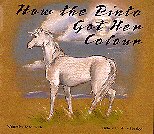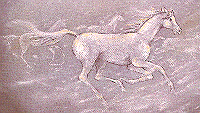


|
How the Pinto Got Her Colour.
Kate Buchholz. Illustrated by Anne Hanley.
Grades 4 - 6 / Ages 9 - 11.
|
excerpt:
It was at dawn, on an early spring day, when the Great Spirit's favorite mare gave birth to a lovely filly. Although the sun had appeared in the east as a fiery orange ball, its rays had not yet warmed the ground the foal was born upon. The winter frost was slowly coming out of the earth, causing wispy clouds of steam to rise and drift about. It gently covered the mare with a soft, white blanket as if assuring her of privacy while she laboured to bring the foal into this world. With one last strong contraction the mare lifted her head, causing a break in the mist, and the wet, slippery foal made her debut.
 In the time before horses were differently coloured, they were all white, causing no end of confusion. In the story that Kate Buchholz tells, the Great Spirit, displeased with this situation, finds a way to make horses distinct from one another. It is the bond that grows between a young native girl, Breeze, and her horse, Tiana, that leads the Great Spirit to the way to make pinto ponies distinct among horses. How the Pinto Got Her Colour is very much about the love of Breeze for her grandfather, her people, and her horse; and the strength that love gives Breeze to overcome adversity.
In the time before horses were differently coloured, they were all white, causing no end of confusion. In the story that Kate Buchholz tells, the Great Spirit, displeased with this situation, finds a way to make horses distinct from one another. It is the bond that grows between a young native girl, Breeze, and her horse, Tiana, that leads the Great Spirit to the way to make pinto ponies distinct among horses. How the Pinto Got Her Colour is very much about the love of Breeze for her grandfather, her people, and her horse; and the strength that love gives Breeze to overcome adversity.


Highly recommended.
Kenneth Field is a librarian for Traill College at Trent University in Peterborough, ON.
To comment on this title or this review, send mail to cmeditor@mts.net
![]()
Copyright © 1995 the Manitoba Library Association.
Reproduction for personal use is permitted only if this copyright notice
is maintained. Any other reproduction is prohibited without permission.
Published by
The Manitoba Library Association
ISSN 1201-9364
 Go back to CM Welcome page
Go back to CM Welcome page
 Go back to Table of Contents for this Issue
Go back to Table of Contents for this Issue